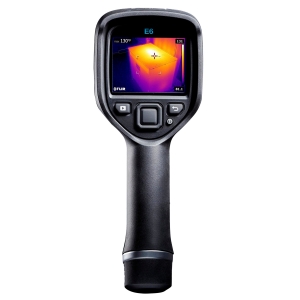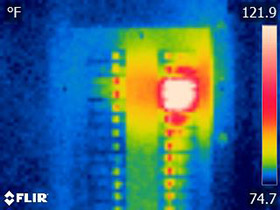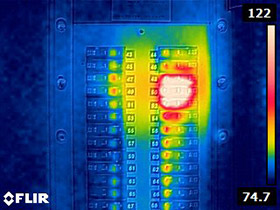 FLIR today announced the launch of an innovative new line of thermal cameras, the FLIR Ex-Series. Four completely new thermal cameras make up the Ex-Series, the FLIR E4, FLIR E5, FLIR E6, and FLIR E8. Our first impression upon wielding one of the new cameras is completely tactile–the fit and finish is more consistent with the latest iPhone release than with a piece of technology aimed at breaking price barriers. All four Ex-Series thermal cameras share a beautiful black and silver housing, which despite its sleek finish, can withstand a six foot drop and return to active duty.
FLIR today announced the launch of an innovative new line of thermal cameras, the FLIR Ex-Series. Four completely new thermal cameras make up the Ex-Series, the FLIR E4, FLIR E5, FLIR E6, and FLIR E8. Our first impression upon wielding one of the new cameras is completely tactile–the fit and finish is more consistent with the latest iPhone release than with a piece of technology aimed at breaking price barriers. All four Ex-Series thermal cameras share a beautiful black and silver housing, which despite its sleek finish, can withstand a six foot drop and return to active duty.
Pricing tiers are centered around imaging performance rather than additional software features, with each successive camera offering a meaningful hardware difference. The resolution ranges from 80 x 60 in the FLIR E4 all the way to an impressive 320 x 240 in the FLIR E8. Important to note is that, as far as the building community is concerned, the FLIR E6 thermal camera will be the one to fill the shoes of the outgoing FLIR i7. The E6 meets and exceeds the RESNET Guidelines for Thermographic Inspections of Buildings.
| FLIR E4 | FLIR E5 | FLIR E6 | FLIR E8 | |
| IR Resolution | 80 × 60 | 120 × 90 | 160 × 120 | 320 × 240 |
| Thermal Sensitivity | 0.15°C | 0.10°C | 0.06°C | 0.06°C |
| Price | $995.00 | $1,495.00 | $2,495.00 | $5,995.00 |
One surprising development is that FLIR has included their new MSX imaging technology in all four of these cameras. MSX stands for Multi Spectral Dynamic Imaging and offers a new way of blending visual and thermal images. All cameras in the new Ex-Series include a 3.1 megapixel digital camera to capture visible images with each thermal image–a great new feature in its own right. MSX extracts data from the visible light image and embosses it on the thermal image using proprietary algorithms. The net effect is an image that shows full thermal data without any loss, as well as all pertinent visual data.
After using the new Ex-Series for a while, our opinion is that MSX really changes the game in the lower resolutions. The E4 and E5 (like the outgoing i-Series) contain thousands of points of excellent thermal data. The problem has been in correlating this data to the target itself. With the new MSX enhancement, even lower resolutions have a sense of “clarity” that only higher resolutions cameras had before. The thermal data is the same, but it just feels much more usable in the MSX view.
Another standout feature of the E4/E5/E6/E8 cameras is the introduction of a 45-degree lens as standard fitment. Most FLIR thermal cameras are shipped with a 25-degree lens, which when combined with higher resolution, gives a great balance of field of view and measurement spot size. With the new Ex-Series, FLIR has decided in favor of a larger FOV, and we have to agree with that decision. As with the MSX, this is an advancement that makes the camera fundamentally more useful in most field conditions. The user can see more of a wall, roof, or electrical panel in just one image, saving time in the field, and making for simpler reporting.
 One final development worth noting is the introduction of a new menu navigation system. While that may not initially seem like news, the intuitiveness of the menu really is much improved. This has also allowed for the simplification of the buttons on the camera itself. To this reviewers eye, the system now functions more like an Apple product or any newer smart phone. To anyone who has ever had to fumble through menu systems three times, trying to remember where some setting was, this is a welcome change.
One final development worth noting is the introduction of a new menu navigation system. While that may not initially seem like news, the intuitiveness of the menu really is much improved. This has also allowed for the simplification of the buttons on the camera itself. To this reviewers eye, the system now functions more like an Apple product or any newer smart phone. To anyone who has ever had to fumble through menu systems three times, trying to remember where some setting was, this is a welcome change.
With so many hardware and software innovations, price is almost an afterthought with the new Ex-Series. But FLIR has tackled that one too, offering the new FLIR E4 thermal camera for a list price of just $995. That’s a true thermal camera with almost 5000 pixels for under a grand. On the other end of the spectrum is the E8 at $5995, which is a full $2000 less than the going rate for other quality 320 x 240 thermal cameras.
The verdict? Let’s do a little math: more features, plus better resolution, plus lower pricing. It all adds up to a great step forward for users of infrared.
For more information about the new FLIR Ex-Series Thermal Cameras, see full features and specifications at Ivy Tools. Or feel free to give us a call at (877) 273-2311.


Hi. I run a plumbing business and am wanting to purchase an E4 purely to assist with leak detection in conjunction with sonic. Dont want to spend to much on thermal, but also dont want to buy something unsuited. Would the E4 be adequate for my purpose, and can I use the included Flir tools software to do basic reports for insurance companies and home owners, or do I HAVE to purchase the Reporter software. I do not need to do full building structural reports.
Bernard – The FLIR E4 may do the job for you, depending on what kind of leaks you are looking for. If you want to see water running down a bare pipe, or hot water pooling under pipe insulation, the E4 is probably up to the task. A little more sensitivity and resolution would go a long way in finding the trickier leaks. Leaks in walls or under slabs, or close to ambient temperature would be easier to detect with a camera like the FLIR E6 or especially the FLIR E8. The higher resolution and better sensitivity of these cameras really pays dividends when looking for subtle temperature differences and patterns. Let me know if I can be of any more help.
So Bernard what did you buy and how is it working? Thanks
I am a home inspector and am wondering if the E4 would be acceptable for “Energy Assessments” for my clients or would I need to use the E5. I am concerned the pictures from the E4 would not be good enough. After seeing the picture above, I am now really wondering. Is there a chance you would post or send out more pictures from each camera? It comes down to price and resolution for me really. I will not be doing full energy audits but it would be a nice add on to be able to assist my clients by pointing out issues during the inspection.
Mike – Most folks in the home inspection and energy auditing field go with the FLIR E6 or another 160 x 120 thermal camera. It has the features to help make the most of building inspections, and also meets the RESNET guidelines. The E6 has four times more resolution than the E4, and is more than twice as sensitive to temperature variations. These features can make a big difference when looking for the subtle temperature patterns often associated with building airflow and moisture issues.
Can you find problems in a building using the FLIR E4 or FLIR E5? Absolutely. And if that’s what meets the budget, I’d sooner do an inspection with an E4 or E5 than without it. But other problems will likely go undetected. The FLIR E6 has the resolution and sensitivity to help the user find most building problems under the right conditions. Of course, as anyone with a 320 x 240 infrared camera will tell you, even more resolution helps even more!
Is an E5 capable of dectecting white ants in a brick building, under concrete,slabs and though tile covered timber floors and find white ants in timber joist.
Colin – Ants can certainly be located in buildings with infrared (as can termites, bees, and other insect colonies). Finding them under a concrete slab or tile floors would be difficult, however. Under the right conditions it is possible, but there would have to be a significant amount of heat from the insects congregating to overcome the cooling effects of the concrete or tile. Colonies behind drywall or in wood framing are significantly easier to find.
Either way, the E5 is probably not the camera for this job. I would look for something with much more sensitivity, like one of the FLIR bx cameras. These are intended for building use and have a much better sensitivity to slight temperature variations. The FLIR E40bx, for instance, has more than double the sensitivity of the FLIR E5. Most contractors looking for small pests go with something in this range. It’s more money to be sure, but it gets the results you’re looking for. Best of luck.